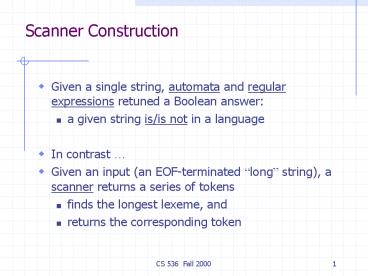Scanner Construction - PowerPoint PPT Presentation
Title:
Scanner Construction
Description:
a given string is/is not in a language. In contrast ... Given an input (an EOF-terminated 'long' string), a scanner returns ... such DFA is called a transducer ... – PowerPoint PPT presentation
Number of Views:25
Avg rating:3.0/5.0
Title: Scanner Construction
1
Scanner Construction
- Given a single string, automata and regular
expressions retuned a Boolean answer - a given string is/is not in a language
- In contrast
- Given an input (an EOF-terminated long string),
a scanner returns a series of tokens - finds the longest lexeme, and
- returns the corresponding token
2
Putting it all together
NFA
Regular expressions
DFA
Lexical Specification
Table-driven Implementation of DFA
3
Lets build a scanner for a very simple language
- The language of assignment statements
- LHS RHS LHS RHS
- left-hand side of assignment is a Pascal
identifier - a letter followed by one or more letters or
digits - right-hand side is one of the following
- ID ID
- ID ID
- ID ID
4
Step 1 Define tokens
- Our language has five tokens,
- they can be defined by five regular expressions
5
Step 2 Convert REs to NFAs
ASSIGN
letter
ID
letter digit
PLUS
TIMES
EQUALS
6
Step 4 Combining per-token DFAs
- Goal of a scanner
- find the longest prefix of the current input that
corresponds to a token. - This has two consequences
- lookahead
- Examine if the next input character can extend
the current token. If yes, keep building a
larger token. - a real scanner cannot get stuck
- What if we get stuck building the larger token?
Solution return characters back to input.
7
Furthermore
- In general the input can correspond to a series
of tokens (lexemes), not just a single token. - Problem It is no longer correct to run the FSM
until it gets stuck or whole string is consumed.
So, how to partition the input into lexemes? - Solution a token must be returned when a regular
expression is matched. - Some lexemes (like whitespace and comments) do
not correspond to tokens. - Problem how to discard these lexemes?
- Solution after finding such a lexeme, the
scanner simply starts again and tries to match
another regular expression.
8
Extend the DFA
- modify the DFA so that an edge can have
- an associated action to
- "put back one character" or
- "return token XXX",
- such DFA is called a transducer
- we must combine the DFAs for all of the tokens in
to a single DFA, and
9
Step 4 Example of extending the DFA
- The DFA that recognizes Pascal identifiers must
be modified as follows - recall that scanner is called by parser (one
token is return per each call) - hence action return puts the scanner into state S
- action
- put back 1 char
- return ID
letter digit
letter
S
any char except letter or digit
10
Implementing the extended DFA
- The table-driven technique works, with a few
small modifications - Include a column for end-of-file
- e.g., to find an identifier when it is the last
token in the input. - besides next state, a table entry includes
- an (optional) action put back n characters,
return token - Instead of repeating
- "read a character update the state variable"
until the machine gets stuck or the entire input
is read, - "read a character update the state variable
perform the action" - (eventually, the action will be to return a
value, so the scanner code will stop).
11
Step 4 Example Combined DFA for our language
F3
return PLUS
letter digit
put back 1 char return ID
F4
letter
S
any char except letter or digit
return TIMES
F3
ID
return EQUALS
TMP
F5
any char except
put back 1 char return ASSIGN
F1
12
Transition Table (part 1)
13
Transition Table (part 2)
14
TEST YOURSELF 1
- Augment the "combined" finite-state machine to
- Ignore white-spaces between tokens
- white-spaces are spaces, tabs and newlines
- Give an error message if
- a character other than , , , letter, or digit
occurs in the input, or - a digit is seen as the first character in the
current input - (in both cases, ignore the bad character).
- Return an EOF token when there are no more tokens
in the input.































